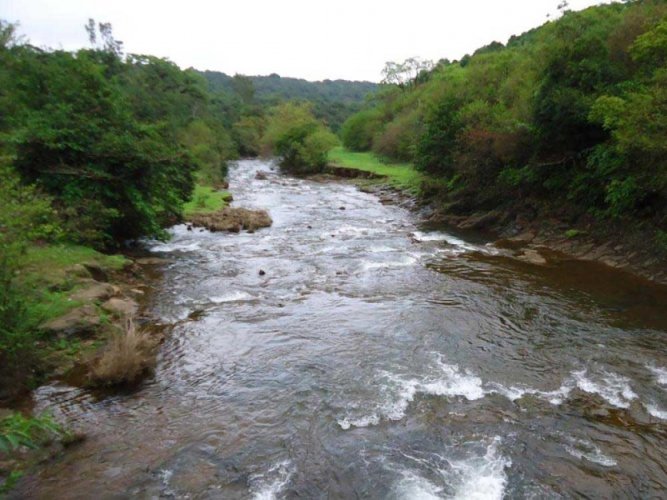
The Mhadei river originates in the forests of Bhimgad in the Khanapur taluka of Belgaum district of Karnataka. Khanapur taluka occupies the area of the historical province of Halsi or Palasige. The temple town of Halsi located in Khanapur was once the capital of the Palasige province.
This Palasige (Khanapur area) was under the control of the Kingdoms of Goa since antiquity. The Bhojas of Chandrapura (Chandor) ruled over Goa, Belgaum and North Kanara from 3-6th century. During the rule of the Kadambas of Goa (10-14th centuries) it again came under the Goan political sphere. Though the capital of the Kadambas of Goa was located at Govapuri (modern Goa Velha), Halsi in the Khanapur taluka was the second capital of the Goan Kadamba kingdom.
Although, the Kadambas in general claimed origin from Banavasi in Karnataka, the Goan Kadambas uniquely claimed a Konkan origin without denying their Banavasi roots as testified by the Asoge copper plates. S G Kadamb, a descendant of the Chitakula Kadambas, proposes Kadamba Plateau of Old Goa/Ribandar as the earliest home of the Kadambas. A small shrine dedicated to Trilochana (originator of the Kadamba family) exists in the modern Sai Baba temple, Kadamba plateau. It is said that the construction work of this temple didn't proceed even though they had enough funds and permission, until the principal Linganath Naik installed an image (murthy) of Trilochana.
Owing to various internal conflicts, invasion of Seuna Yadavas, conflict with Hanagal Kadambas, invasion of Delhi sultanate etc, the Goan Kadamba kingdom was greatly weakened by the end of the 13th century. However, the final blow to the life of Kadambas came from the Vijayanagara kingdom.
The Vijayanagara kingdom, also known as 'Karnata Rajya (Karnata Kingdom), was founded in 1336, as a response to the Islamic invasions to restore the lost glory of Hinduism. In 1344, Goa was attacked by Jamal-Ud-Din of Honnavar, a feudatory of Vijayanagar. The Palasige and Malerajya of the Goan Kadamba kingdom was annexed by the Vijayanagara in 1347 CE, leaving the Goan Kadambas only with Konkana. Thus the province of Halsi (Khanapur taluka) was thereafter lost to the Goan Kadambas.
Around this time, the Bahmani sultans of Deccan also occupied Goa. In the pretext of liberating Goa from the Muslim rule, a Kashmiri Saraswat Brahmin general of the Vijayanagara namely Madhav Mantri annexed Goa around 1379-1380. Goan historian George Moraes states that Madhav Mantri’s conquest of Goa from the Bahmanis was made possible with the support of the vestiges of the Kadamba establishment that still survived. Their understanding was that this Brahmin general would reinstate the old rulers and retire to his own province. Though the Vijayanagara restored some destroyed Hindu temples, they didn't restore the rule to the natives.
The last of the Kadambas and their loyal Kshatriya followers revolted against the Vijayanagara and Madhav Mantri defeated them. The Vijayanagara called these sons of Konkan who opposed them as "some base persons born in the Konkana country" in an inscription dated 1380. Epigraphs around that time celebrate this victory of Karnataka rajya (Vijayanagara) over Goa as "the reducer of the Seven Konkanas to dust", "plunderer of Kadambas" and destruction of Konganigas.
Historian George Moraes states that as a consequence of this Vijayanagara victory, the native Kshatriyas of Goa were punished and the administration of Goa was stripped and replaced first by outsiders and then by the local Brahmins, who slowly worked their way into the favour of Vijayanagar bureaucracy.
George Moraes states that after this event, the torch of freedom was for ever put out in the Konkan and a similar attempt in 1510 to expel the Bijapuris with the help of another foreign power (the Portuguese) only succeeded in exchanging one domination for another. Goa was finally liberated in 1961 and its statehood achieved on 30 May, 1987.
The thirst for an independent rule free from the influence of the outsiders in Goa was lost by the subjugation of the Goan Kadambas by the Karnataka rajya (Vijayanagara) in 1380. The territory of Khanapur (Halsi) which holds the origin of the Mhadei river was also lost to Goa in 1347 because of the same Vijayanagara kingdom.
Now, after almost 675 years, the rights over river Mhadei which quenches the thirst of Goan people is again threatened by the state of Karnataka. There is no denial that the thirst for Mhadei is also a righteous thirst for the right to have independence from external powers.
(The writer is a Goa-based researcher on the Carmelite religious congregation)